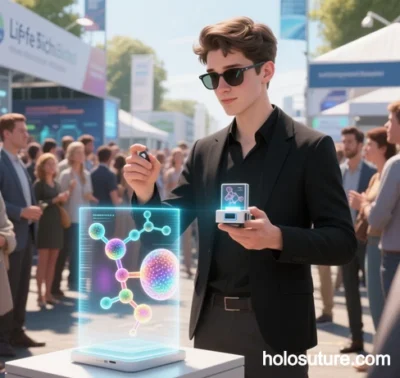
HoloSuture: The Revolutionary Integration of Holography and Minimally Invasive Surgical Suturing
The fusion of holography with minimally invasive suturing techniques is redefining the precision and safety of surgical procedures. The Holo Suture medical system addresses critical challenges in traditional minimally invasive surgery—such as limited visibility, operational blind spots, and insufficient suturing accuracy—through dynamic 3D visualization, real-time navigation, and intelligent feedback mechanisms. Below is an in-depth analysis of its technical architecture, clinical applications, value propositions, and future evolution.
I. Technical Architecture: Multimodal Fusion of Holographic-Suturing Systems
The Holo Suture system comprises three core modules, enabling closed-loop surgical support through algorithm-hardware synergy:
Holographic Imaging Layer
- Multimodal Data Fusion: Integrates preoperative CT/MRI scans, intraoperative ultrasound/fluorescence imaging, and real-time endoscopy to build dynamic 4D holographic models of organs (anatomy + blood flow/tissue deformation).
- Nanoscale Phase Control: Utilizes nano-antenna chips and holographic algorithms developed by Tel Aviv University to project distortion-free 3D images from any angle with 0.1mm resolution.
Intelligent Suturing Navigation Layer
- Holographic Marking & Path Planning: AI segmentation automatically labels sensitive areas (vessels, nerves) in holographic models, generating risk-avoidance suturing paths (e.g., bypassing coronary artery branches).
- Force Feedback Synchronization: Tactile sensors linked to holographic interfaces allow surgeons to “feel” virtual sutures, simulating tissue tension and elasticity to prevent over-pulling.
Adaptive Execution Layer
- Robotic Suturing Arm: Instruments with micro-holographic projectors overlay real-time suturing markers (e.g., optimal vascular anastomosis angles) during operations.
- Bioadhesive Monitoring: Holographic interferometry evaluates micro-deformations during adhesive curing to ensure sealing strength and tissue compatibility.
II. Clinical Applications: Precision Advancements Across Specialties
Cardiovascular Anastomosis
- Use Case: In minimally invasive coronary bypass surgery, Holo Suture projects beating-heart holograms to mark calcified plaques and anastomosis targets. Surgeons rotate holograms via gesture control to plan optimal paths (avoiding ventricular weak zones), with robotic arms achieving <50μm suturing errors.
Gastrointestinal Reconstruction
- Advantage: Guides post-esophagectomy tubular gastrectomy-esophageal anastomosis using real-time fluorescence-based perfusion heatmaps to optimize suture density and prevent ischemic leaks.
- Data: Clinical trials show Holo Suture reduces postoperative anastomotic leakage from 12% to 2.3%.
Nerve Sheath Repair
- Innovation: Philips interventional ultrasound integration enables holographic tracking of microscopic nerve bundles (20μm resolution), aligning suture spacing with axonal regeneration pathways.
Tumor Margin Delineation
- Multispectral Fusion: Combines tumor fluorescence markers (e.g., ICG) with AI-powered pathological boundary prediction for submillimeter precision in breast-conserving surgeries.
III. Clinical Value: 3D Intelligence-Driven Breakthroughs
Spatial Cognition Revolution
- Replaces error-prone 2D screens (30% depth misjudgment rate) with interactive 3D holograms, quadrupling spatial positioning accuracy.
Real-Time Dynamic Response
- 120Hz holographic updates synchronize with physiological motions (e.g., respiratory shifts), maintaining <0.5mm alignment between markers and tissues.
Cross-Disciplinary Integration
- AI Suturing Library: Embeds biomechanical parameters from thousands of successful surgeries (e.g., tissue-specific tension thresholds), guiding optimal needle angles via augmented reality prompts.
Training & Quality Control
- Holographic simulators generate rare anatomical variations (e.g., aberrant hepatic arteries), allowing trainees to practice virtual suturing with force feedback. Systems provide real-time scoring and improvement reports.
IV. Challenges and Future Evolution
Technical Bottlenecks
- Latency Reduction: Current hologram-robot latency (~80ms) requires spiking neural networks (SNN) to achieve sub-15ms performance for dynamic organ applications.
- Multimodal Calibration: Quantum sensor-based protocols synchronize ultrasound, endoscopy, and holography to resolve millisecond-level timing mismatches.
Clinical Implementation
- Modular Design: ShengXing Medical’s “Holo-Navigation System” (NMPA-pending) offers open interfaces for third-party robotic integration, accelerating adoption.
- Cost Optimization: Diffractive optical components could cut device costs from 500Kto200K.
Next-Gen Innovations
- Adaptive Holography: Intraoperative OCT scans update holograms in real time, dynamically adjusting suturing strategies (e.g., recommending absorbable sutures based on tissue edema).
- 5G Remote Suturing: Low-latency holographic streaming and haptic gloves enable experts to guide complex vascular anastomoses remotely.
V. Ethics and Standardization
Accountability
- Clarify legal liability when AI-recommended paths deviate from surgical outcomes (e.g., complications from navigation discrepancies).
Data Security
- Federated learning and blockchain secure holographic surgical data (containing biometrics) for cross-hospital sharing and auditing.
Standardization
- ISO/TC 299 is drafting interoperability standards for hologram-robot systems, covering image resolution and force feedback precision.
Conclusion: From Visual Aid to Intelligent Symbiosis
Holo Suture marks a paradigm shift from “instrumental operation” to “holographic intelligence interaction.” When holograms evolve from static anatomical projections to living digital twins integrating physiological dynamics, biomechanical feedback, and AI prediction, minimally invasive suturing will transcend human sensory and cognitive limits. Future integration with brain-computer interfaces may allow surgeons to adjust suturing parameters via thought—ushering in an era of “precision beyond touch.”
Data sourced from public references. For collaboration or domain inquiries, contact: chuanchuan810@gmail.com





